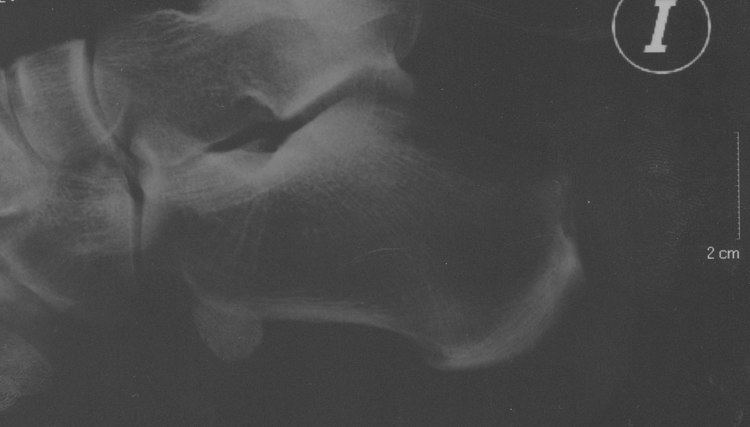 | ||
Haglund's deformity (also referred to as Mulholland deformity, retrocalcaneal bursitis, posterior calcaneal tuberosity, and pump bump) is a bony enlargement on the back of the heel that most often leads to painful bursitis, which is an inflammation of the bursa (a fluid-filled sac between the tendon and bone). In Haglund's deformity, the soft tissue near the Achilles tendon becomes irritated when the bony enlargement rubs against shoes.
Contents
Haglund's deformity is often called "pump bump" because the rigid backs of pump-style shoes can create pressure that aggravates the enlargement when walking.
Symptoms
Haglund's deformity can occur in one or both feet. The signs and symptoms include:
Causes
To some extent, heredity plays a role in Haglund's deformity. People can inherit a type of foot structure that makes them prone to developing this condition.
For example, high arches can contribute to Haglund's deformity. The Achilles tendon attaches to the back of the heel bone, and in a person with high arches, the heel bone is tilted backward into the Achilles tendon. This causes the uppermost portion of the back of the heel bone to rub against the tendon. Eventually, due to this constant irritation, a bony protrusion develops and the bursa becomes inflamed. It is the inflamed bursa that produces the redness and swelling associated with Haglund's deformity.
A tight Achilles tendon can also play a role in Haglund's deformity, causing pain by compressing the tender and inflamed bursa. In contrast, a tendon that is more flexible results in less pressure against the painful bursa.
Another possible contributor to Haglund's deformity is a tendency to walk on the outside of the heel. This tendency, which produces wear on the outer edge of the sole of the shoe, causes the heel to rotate inward, resulting in a grinding of the heel bone against the tendon. The tendon protects itself by forming a bursa, which eventually becomes inflamed and tender.
Diagnosis
After evaluating the patient's symptoms, the foot and ankle surgeon will examine the foot. In addition, x-rays will be requested to help the surgeon evaluate the structure of the heel bone.
Treatment
Non-surgical treatment of Haglund's deformity is aimed at reducing the inflammation of the bursa. While these approaches can resolve the bursitis, they will not shrink the bony protrusion. Non-surgical treatment can include one or more of the following:
If non-surgical treatment fails to provide adequate pain relief, surgery may be needed consisting of debridement of the affected Achilles tendon and excision of the retrocalcaneal bursa and the Haglund deformity. A central approach facilitates such debridement but necessitates detachment of 50% of the Achilles tendon from the calcaneus which is usually sutured back using bone anchors. In severe cases necessitating debridement of a substantial portion of the Achilles tendon, augmentation may be done with the transfer of the flexor hallucis longus muscle.
Prevention
A recurrence of Haglund's deformity may be prevented by:
